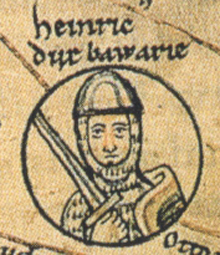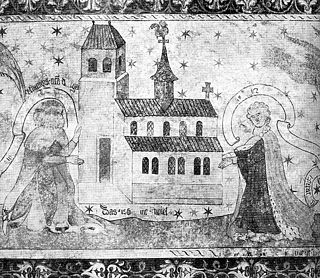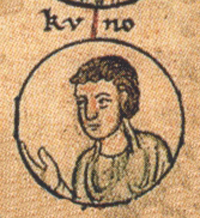Egeno I of Konradsburg (also Conradsburg) was one of the free knights ( Edelfrei ) of Konradsburg, in the northeast of the Harz region of Germany, near Ermsleben.
The term edelfrei or hochfrei was originally used to designate and distinguish those Germanic noblemen from the Second Estate, who were legally entitled to atonement reparation of three times their "Weregild" (Wergeld) value from a guilty person or party. Such knights were known as Edelfreie or Edelinge. This distinguished them from those other free men or free knights who came from the Third Estate social hierarchy, and whose atonement reparation value was the standard "Weregild" (Wergeld) amount set according to regional laws. In the Holy Roman Empire, the "high nobility" emerged from the Edelfreie during the course of the 12th century, in contrast to the so-called ministeriales, most of whom were originally unfree knights or Dienstadel.

The Konradsburg is a former castle, monastery and manor house near Ermsleben in the German federal state of Saxony-Anhalt.
In 1070, Egeno I claimed publicly that he knew of a conspiracy by the Saxon counts and the Duke of Bavaria, Otto II of Northeim, against King Henry IV and, as part of this, had even received an order to murder the king. The aim of this ploy was apparently the complete disempowerment of the Duke of Bavaria and expropriation of his estates, giving Henry IV easy access to the Saxon and Thuringian lands. As Otto himself refused the consequent ordeal - a duel with Egeno who was of much lower standing in the social order and of bad reputation - the imperial ban was imposed on him. Otto took up arms in alliance with Magnus Billung but was defeated in 1071 and was imprisoned for a time.
Reputation or image of a social entity is an opinion about that entity, typically as a result of social evaluation on a set of criteria.
The imperial ban was a form of outlawry in the Holy Roman Empire. At different times, it could be declared by the Holy Roman Emperor, by the Imperial Diet, or by courts like the League of the Holy Court (Vehmgericht) or the Reichskammergericht.
Count Giso II of the House of Giso and Count Adalbert of Schauenburg were named as the instigator and author of the conspiracy. They were supposed to have concocted the plan, probably with the knowledge of Henry IV, drawn up the indictment and publicised it through Egeno, whom they had bribed. Giso and Adalbert were killed in 1073 by Otto's henchmen at the Giso Castle of Hollende.
Egeno was blinded in 1073 as a punishment for robbery and then travelled through the land as a beggar.

Babenberg was a noble dynasty of Austrian margraves and dukes. Originally from Bamberg in the Duchy of Franconia, the Babenbergs ruled the Imperial Margraviate of Austria from its creation in 976 AD until its elevation to a duchy in 1156, and from then until the extinction of the line in 1246, whereafter they were succeeded by the House of Habsburg.

Conrad I, called the Younger, was the king of East Francia from 911 to 918. He was the first king not of the Carolingian dynasty, the first to be elected by the nobility and the first to be anointed. He was chosen as the king by the rulers of the East Frankish stem duchies after the death of young king Louis the Child. Ethnically Frankish, prior to this election he had ruled the Duchy of Franconia from 906.

Frederick II, called the One-Eyed, was Duke of Swabia from 1105 until his death, the second from the Hohenstaufen dynasty. His younger brother Conrad was elected King of the Romans in 1138.
Eberhard III, a member of the Conradine dynasty, was Duke of Franconia, succeeding his elder brother, King Conrad I, in December 918. From 926 to 928, he also acted as ruler of Lotharingia.
Conrad, called the Red, was Duke of Lorraine from 944 until 953. He became the progenitor of the Imperial Salian dynasty.
Magnus was the duke of Saxony from 1072 to 1106. Eldest son and successor of Ordulf and Wulfhild of Norway, he was the last member of the House of Billung.
Otto of Nordheim was Duke of Bavaria from 1061 until 1070. He was one of the leaders of the Saxon Rebellion in 1073-75 and the Great Saxon Revolt of 1077-88 against King Henry IV of Germany.

Henry I, a member of the German royal Ottonian dynasty, was Duke of Bavaria from 948 until his death.

The Duchy of Swabia was one of the five stem duchies of the medieval German kingdom. It arose in the 10th century in the southwestern area that had been settled by Alemanni tribes in Late Antiquity.
Egbert II was Count of Brunswick and Margrave of Meissen. He was the eldest son of the Margrave Egbert I of the Brunonen family.

The War of the Three Henries was a brief rebellion of three German princes, all called Henry, against Emperor Otto II in 977–978.
Henry III, called the Younger, a member of the Luitpolding dynasty, was the first Duke of Carinthia from 976 to 978, Duke of Bavaria from 983 to 985 and again Duke of Carinthia from 985 to 989.

Burchard III, a member of the Hunfriding dynasty, was the count of Thurgau and Zürichgau, perhaps of Rhaetia, and then Duke of Swabia from 954 to his death.

Conrad I, a member of the Salian dynasty, was Duke of Carinthia from 1004 until his death.

Falkenstein/Harz is a town in the Harz district, in Saxony-Anhalt, Germany. It was created in 2002 by merging the town of Ermsleben with the former municipalities of Endorf, Meisdorf, Neuplatendorf, Pansfelde, Reinstedt und Wieserode. The new community was named after Falkenstein Castle.

Adalbert II of Ballenstedt, an early member of the House of Ascania, was Graf (count) in Saxony and Vogt of Nienburg Abbey.
Lothair Udo II was Margrave of the Nordmark from 1057 until his death and also Count of Stade. He was the only son of Lothair Udo I of the Udonids and Adelaide of Rheinfelden.

Otto I, traditionally known as Otto the Great, was German king from 936 and Holy Roman Emperor from 962 until his death in 973. He was the oldest son of Henry I the Fowler and Matilda.

The Saxon Rebellion or Rebellion of the Saxons, also commonly called the Saxon Uprising, refers to the struggle between the Salian dynasty ruling the Holy Roman Empire and the rebel Saxons during the reign of Henry IV. The conflict reached its climax in the period from summer 1073 until the end of 1075, in a rebellion that involved several clashes of arms.
This page is based on this
Wikipedia article Text is available under the
CC BY-SA 4.0 license; additional terms may apply.
Images, videos and audio are available under their respective licenses.












